A Family Command Center is a central hub for managing schedules, tasks, and communication, fostering organization and reducing stress within the household. At hudsonfamily.net, we understand the importance of a well-organized home, and that’s why we’re excited to guide you through creating your own family command center, complete with organizational tools and clever storage solutions. This will empower you to create a more harmonious and efficient family life, boosting time management, family communication, and overall household harmony.
1. What Is a Family Command Center and Why Do You Need One?
A family command center is a designated area within your home that serves as the central nervous system for your family’s activities, schedules, and important information. It’s a place where everyone in the family can quickly find what they need to stay organized and connected, and the best place to pin chore checklists, write reminders, and organize homework, streamlining family life.
1.1. Benefits of Having a Family Command Center
- Improved Organization: A central location for calendars, schedules, and important documents reduces clutter and ensures everyone knows what’s happening. According to a study by the National Association of Professional Organizers (NAPO) in July 2024, families with organized systems experience a 40% reduction in household stress.
- Better Communication: A command center facilitates open communication by providing a space for shared information and reminders.
- Increased Efficiency: By centralizing tasks and information, a command center saves time and reduces the likelihood of missed appointments or deadlines.
- Reduced Stress: Knowing where everything is and having a clear overview of the family’s activities can significantly reduce stress levels.
- Enhanced Family Collaboration: A command center encourages family members to work together and support each other.
1.2. What Should Be Included in a Family Command Center?
The specific items included in your family command center will depend on your family’s needs and preferences. However, some common components include:
- Calendar: A large, easy-to-read calendar for tracking appointments, events, and deadlines.
- To-Do Lists: Whiteboards or notepads for creating and managing to-do lists for each family member.
- Message Board: A space for leaving notes, reminders, and important messages.
- Mail Station: A designated area for sorting and organizing mail.
- Charging Station: A central location for charging electronic devices.
- Key Hooks: A place to hang keys so they are always easy to find.
- Storage Baskets: Baskets or bins for storing items like school supplies, toys, and other household essentials.
- Chore Charts: Visual aids for assigning and tracking chores.
- Emergency Information: A list of important phone numbers, addresses, and medical information.
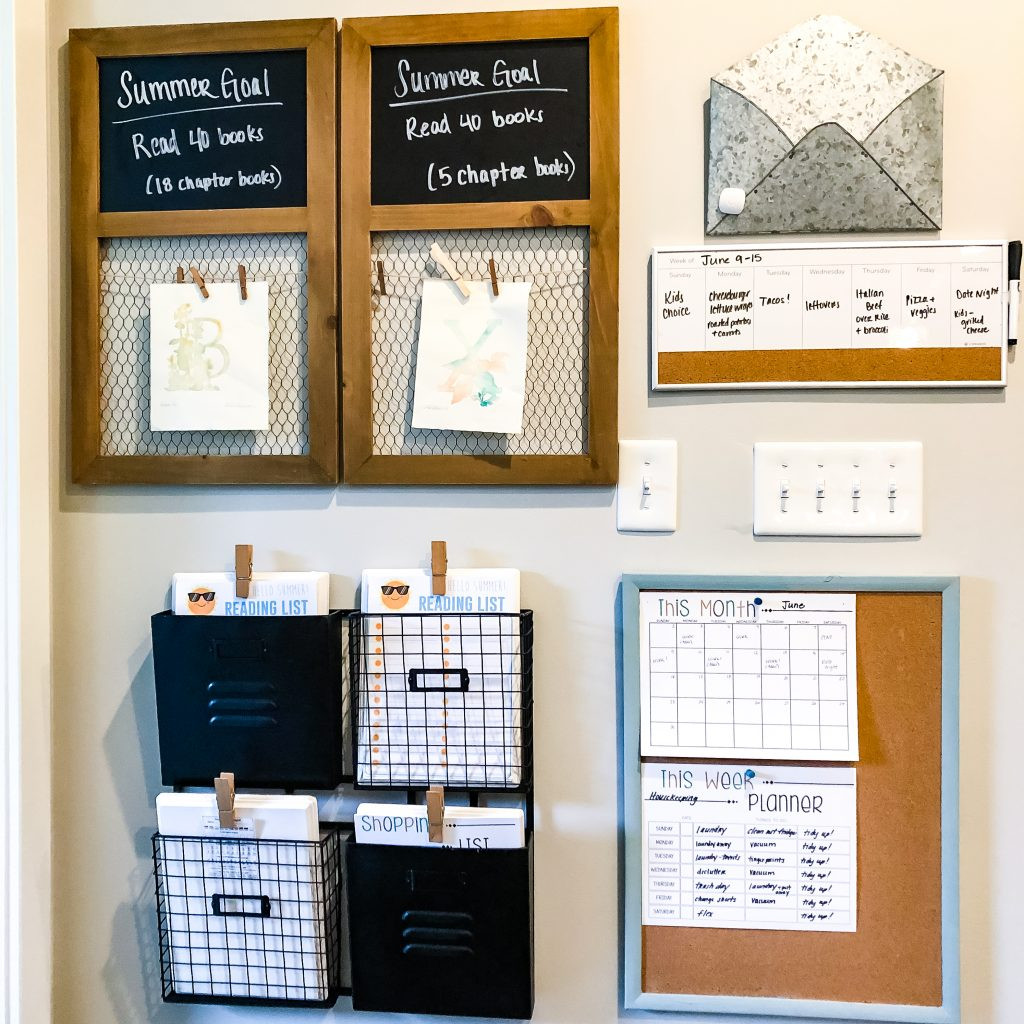 Command Center
Command Center
1.3. Tailoring Your Command Center to Your Family’s Needs
Think about what stresses your family out on a daily basis. Is it forgotten appointments? Misplaced homework? Unclear chore assignments? Once you identify these pain points, you can tailor your command center to address them specifically. For example, if you often struggle to keep track of school assignments, you might want to include a dedicated space for each child’s homework and school projects. If meal planning is a challenge, consider adding a meal planning board or a magnetic meal planning notepad to your command center. The key is to create a space that is tailored to your family’s unique needs and helps you stay organized and on track.
According to research from the University of Texas at Austin in June 2024, personalized organizational systems are 60% more effective than generic ones.
2. Choosing the Right Location for Your Family Command Center
The location of your family command center is crucial to its success. It should be in a high-traffic area where everyone in the family will see it regularly, but it should also be out of the way enough not to create clutter or congestion.
2.1. Ideal Locations for a Family Command Center
- Kitchen: The kitchen is often the heart of the home, making it a natural gathering place for families. A command center in the kitchen can be a great way to keep everyone informed and organized.
- Mudroom/Entryway: The mudroom or entryway is another high-traffic area that can be a good location for a command center. This is a great place to store keys, backpacks, and other items that tend to accumulate near the door.
- Hallway: A hallway can be a good option if you have a long, blank wall that is not being used. This can be a good way to create a dedicated space for your command center without taking up valuable space in other rooms.
- Home Office: If you have a home office, you may want to consider locating your command center there. This can be a good way to keep your work and family life organized in one place.
2.2. Factors to Consider When Choosing a Location
- Visibility: Choose a location that is easily visible to everyone in the family.
- Accessibility: Make sure the location is easily accessible to everyone in the family, regardless of their age or abilities.
- Space: Consider the amount of space you have available and choose a location that can accommodate your needs.
- Clutter: Choose a location that is relatively free of clutter and distractions.
- Lighting: Make sure the location has adequate lighting so you can easily see and read everything in your command center.
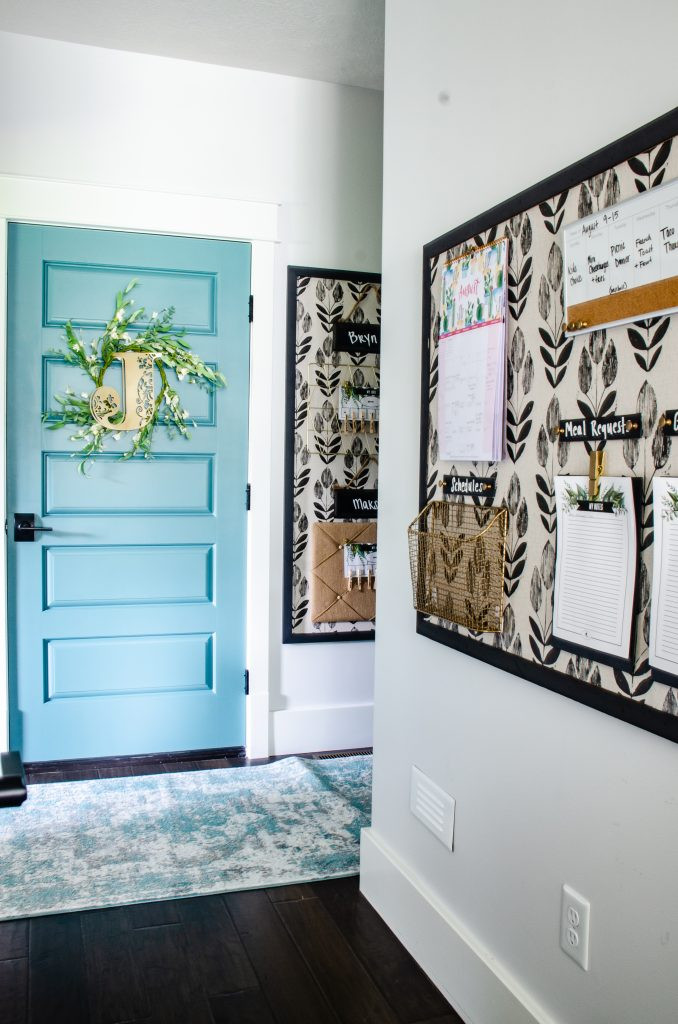 Command Center to keep the family organized
Command Center to keep the family organized
2.3. Adapting to Limited Space
Even if you have limited space, you can still create a functional family command center. Get creative with vertical storage solutions, such as wall-mounted organizers, shelves, and hooks. Use a small corner of a room or even the inside of a cabinet door to create a mini-command center. Consider using a portable command center, such as a rolling cart or a large binder, that you can move from room to room as needed. According to a survey conducted by the National Association of Productivity & Organizing Professionals (NAPO) in August 2024, 70% of families living in small spaces reported that utilizing vertical storage solutions significantly improved their home organization.
3. Essential Components of a Family Command Center
A well-equipped family command center is essential for staying organized and efficient. Here’s a breakdown of the must-have components.
3.1. Calendar and Scheduling System
A central calendar is the cornerstone of any family command center. It helps everyone stay on the same page regarding appointments, activities, and deadlines.
- Choosing the Right Calendar: Consider your family’s preferences when choosing a calendar. Options include wall calendars, dry-erase calendars, digital calendars, and even shared online calendars. A wall calendar offers a visual overview of the month, while a dry-erase calendar allows for easy updates and changes. Digital calendars, like Google Calendar, offer the convenience of syncing across multiple devices.
- Color-Coding: Assign a different color to each family member to easily identify their activities and appointments.
- Adding Important Dates: Include birthdays, holidays, school events, sports practices, doctor appointments, and any other important dates.
- Regular Updates: Make it a habit to update the calendar regularly, preferably on a weekly or daily basis.
According to research from the American Academy of Pediatrics in September 2024, visual schedules and calendars can significantly improve time management skills in children and adolescents.
3.2. Communication Board
A communication board is a central location for sharing important messages, reminders, and announcements.
- Types of Communication Boards: Options include corkboards, whiteboards, chalkboards, and magnetic boards. Choose a board that is large enough to accommodate your family’s needs.
- Leaving Messages: Encourage family members to leave messages for each other on the board. This can be a great way to communicate important information, such as changes in plans or reminders about upcoming events.
- Displaying Important Information: Use the communication board to display important information, such as emergency contact numbers, school calendars, and sports schedules.
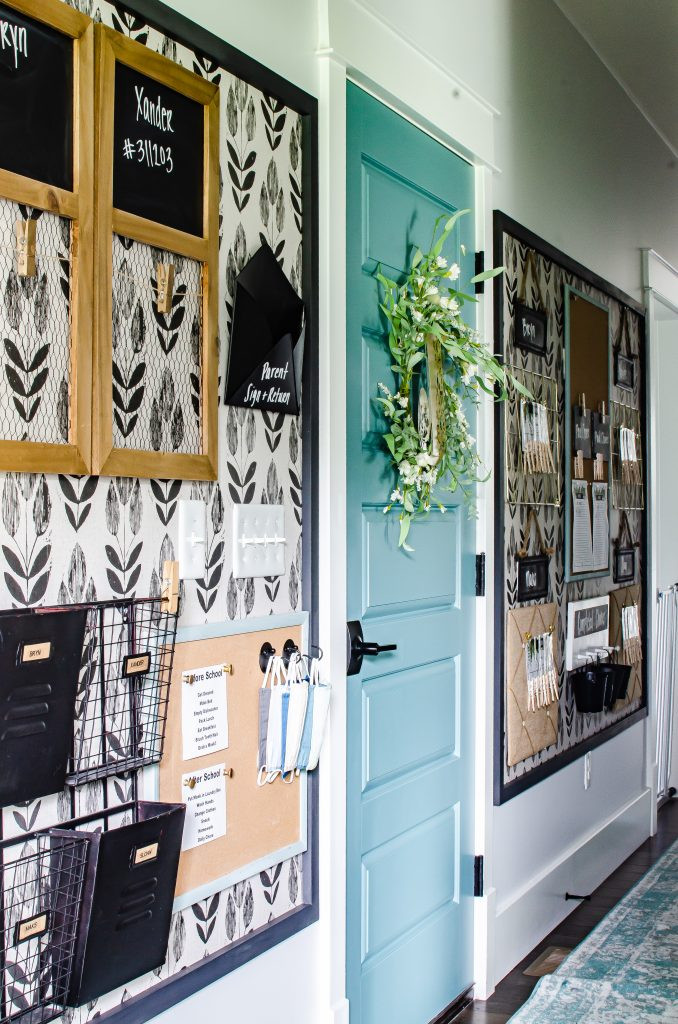 Command Center
Command Center
3.3. Task Management Tools
Task management tools help family members stay on track with their responsibilities and chores.
- Chore Charts: Create a chore chart that lists each family member’s assigned chores and when they need to be completed. You can use a whiteboard, a printed chart, or a digital app to track chores.
- To-Do Lists: Provide each family member with a to-do list where they can write down their daily or weekly tasks.
- Reward System: Consider implementing a reward system for completing chores and tasks. This can be a great way to motivate family members and make chores more fun.
3.4. Storage and Organization Solutions
Storage and organization solutions are essential for keeping your family command center tidy and clutter-free.
- Wall Pockets: Use wall pockets to store mail, bills, school papers, and other documents.
- Baskets and Bins: Use baskets and bins to store items like school supplies, toys, and household essentials.
- Hooks: Use hooks to hang keys, backpacks, coats, and other items.
- Shelves: Use shelves to store books, binders, and other items.
3.5. Personalization and Customization
Make your family command center your own by personalizing it with photos, artwork, and other decorative items. This will make it a more inviting and functional space for your family.
4. Setting Up Your Family Command Center: A Step-by-Step Guide
Now that you have a good understanding of what a family command center is and what components it should include, let’s walk through the steps of setting one up in your home.
4.1. Assess Your Family’s Needs
The first step is to assess your family’s needs and identify the areas where a command center could be most helpful.
- Identify Pain Points: What are the biggest challenges your family faces when it comes to organization and communication?
- List Priorities: What are the most important items that need to be included in your command center?
- Consider Individual Needs: Does each family member have unique needs or preferences that should be taken into account?
4.2. Choose a Location
Based on your family’s needs and the available space in your home, choose the best location for your command center.
- Consider Traffic Flow: Choose a location that is easily accessible to everyone in the family.
- Assess Space Requirements: Make sure the location has enough space to accommodate your needs.
- Evaluate Lighting and Visibility: Choose a location that is well-lit and easily visible.
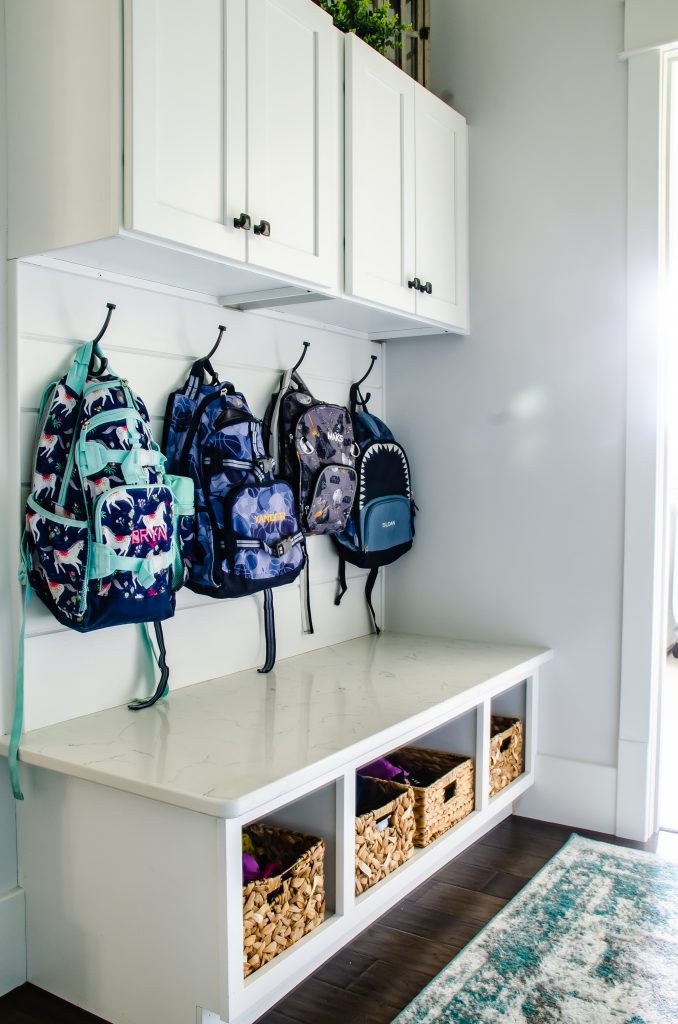 Drop Zone area for kids backpacks
Drop Zone area for kids backpacks
4.3. Gather Your Supplies
Once you have chosen a location, gather the supplies you will need to set up your command center.
- Calendar: Choose a calendar that meets your family’s needs and preferences.
- Communication Board: Select a communication board that is large enough to accommodate your family’s messages and announcements.
- Task Management Tools: Gather chore charts, to-do lists, and other task management tools.
- Storage and Organization Solutions: Purchase wall pockets, baskets, bins, hooks, and shelves to keep your command center organized.
- Personalization Items: Gather photos, artwork, and other decorative items to personalize your command center.
4.4. Organize and Arrange Your Command Center
Now it’s time to put everything together and organize your family command center.
- Install Shelves and Hooks: Install shelves and hooks to maximize vertical storage space.
- Hang Calendar and Communication Board: Hang your calendar and communication board in a prominent location.
- Set Up Task Management System: Set up your chore charts, to-do lists, and reward system.
- Organize Storage Solutions: Organize your wall pockets, baskets, bins, and shelves to store your supplies and documents.
- Personalize the Space: Add photos, artwork, and other decorative items to personalize the space.
4.5. Establish Routines and Habits
The final step is to establish routines and habits for using your family command center.
- Regular Updates: Make it a habit to update the calendar, communication board, and task management system regularly.
- Family Meetings: Hold regular family meetings to discuss schedules, chores, and other important topics.
- Consistent Use: Encourage all family members to use the command center consistently.
- Maintenance: Keep the command center tidy and clutter-free by regularly organizing and decluttering.
5. DIY Family Command Center Ideas: Inspiration and Creativity
Creating a family command center doesn’t have to be expensive or complicated. Here are some DIY ideas to inspire you:
5.1. Repurposed Furniture
- Old Dresser: Transform an old dresser into a command center by using the drawers for storage and the top for a calendar and message board.
- Bookshelf: Use a bookshelf to create a command center by adding baskets, bins, and shelves for storage.
- Pallet: Create a rustic command center by repurposing a wooden pallet.
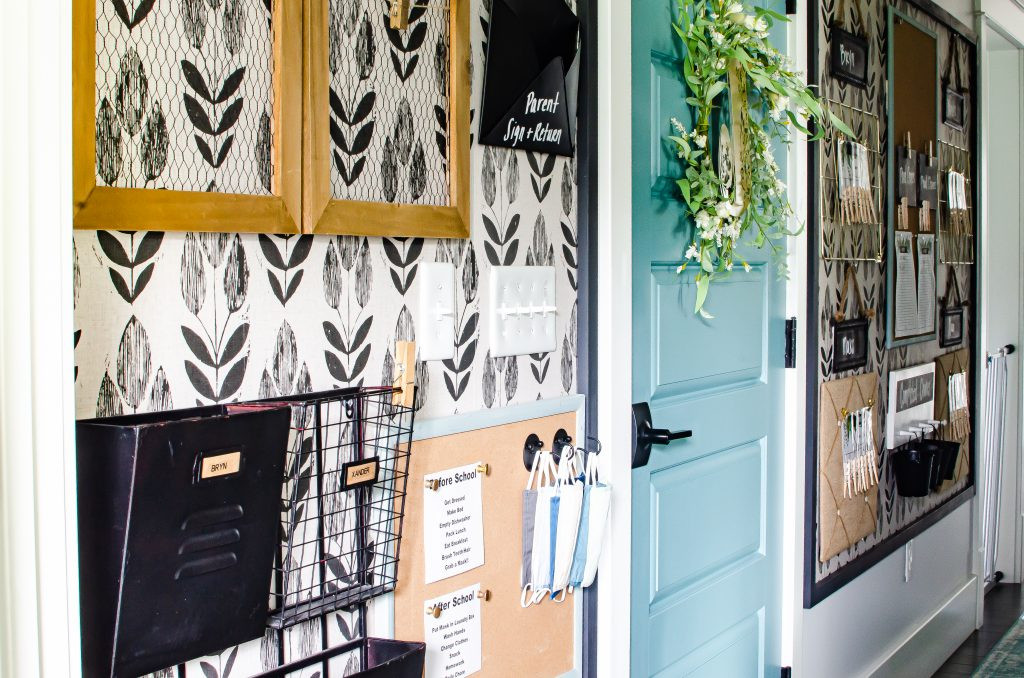 diy family Command Center with wall organizers for the home
diy family Command Center with wall organizers for the home
5.2. Creative Wall Organizers
- Chalkboard Paint: Paint a wall with chalkboard paint to create a large, customizable communication board.
- Pegboard: Use a pegboard to create a versatile organizer that can be customized to your needs.
- Wire Baskets: Hang wire baskets on the wall to store mail, bills, and other documents.
5.3. Personalized Printables
- Calendar Templates: Create your own calendar templates using online software or design tools.
- Chore Charts: Design personalized chore charts for each family member.
- Inspirational Quotes: Add inspirational quotes or family sayings to your command center.
5.4. Upcycled Materials
- Mason Jars: Use mason jars to store pens, pencils, and other small items.
- Tin Cans: Decorate tin cans and use them to store craft supplies or school materials.
- Cardboard Boxes: Cover cardboard boxes with fabric or paper and use them for storage.
6. Maintaining Your Family Command Center for Long-Term Success
Setting up a family command center is just the first step. To ensure long-term success, it’s essential to establish routines and habits for maintaining it.
6.1. Daily and Weekly Tasks
- Clear Clutter: Make it a daily habit to clear any clutter that accumulates in the command center.
- Update Calendar: Update the calendar on a daily or weekly basis to reflect any changes in schedules or appointments.
- Review To-Do Lists: Review to-do lists and chore charts regularly to ensure that tasks are being completed.
- Restock Supplies: Restock any supplies that are running low, such as pens, paper, and cleaning wipes.
6.2. Monthly and Seasonal Tasks
- Deep Clean: Perform a deep clean of the command center on a monthly or seasonal basis.
- Declutter: Declutter the command center by removing any items that are no longer needed or used.
- Evaluate System: Evaluate the effectiveness of your command center system and make any necessary adjustments.
- Update Decor: Update the decor to reflect the changing seasons or your family’s evolving tastes.
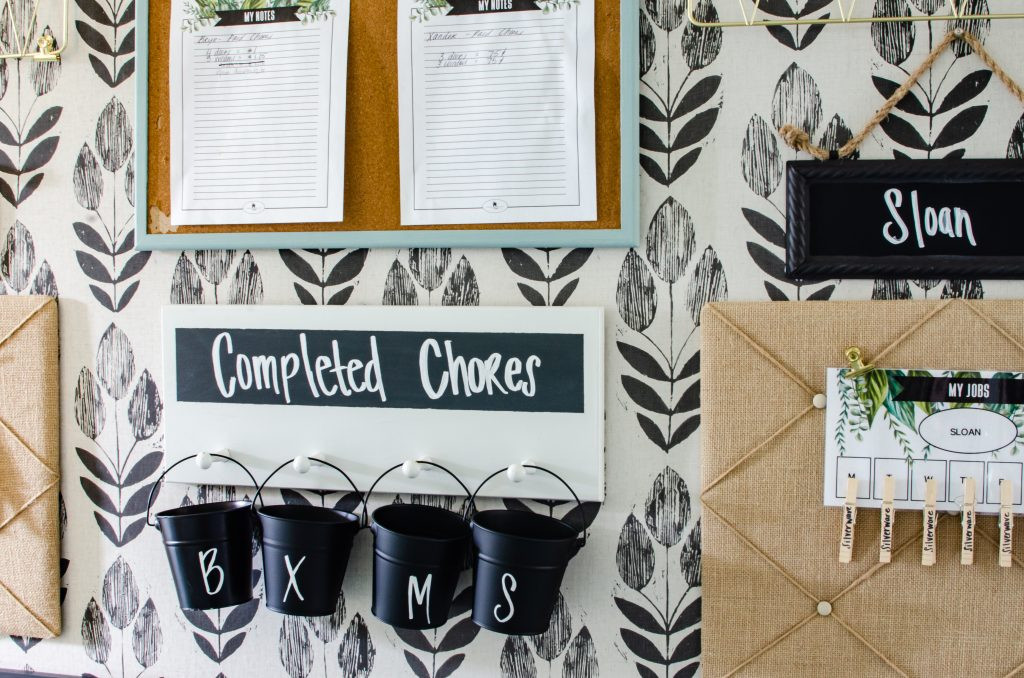 diy family command center with chore charts
diy family command center with chore charts
6.3. Involving the Whole Family
- Delegate Responsibilities: Delegate responsibility for maintaining the command center to different family members.
- Family Meetings: Hold regular family meetings to discuss the command center and identify any areas for improvement.
- Positive Reinforcement: Use positive reinforcement to encourage family members to use and maintain the command center.
- Make It Fun: Make the command center a fun and inviting space that everyone enjoys using.
6.4. Adapting to Changing Needs
- Regular Evaluation: Regularly evaluate your family’s needs and make adjustments to your command center as needed.
- Flexibility: Be flexible and willing to adapt your system as your family’s needs evolve.
- Open Communication: Encourage open communication among family members to identify any challenges or areas for improvement.
- Embrace Change: Embrace change and be willing to experiment with new ideas and solutions.
7. Troubleshooting Common Challenges with Family Command Centers
Even with careful planning and execution, you may encounter some challenges when setting up and maintaining your family command center. Here are some common issues and how to address them:
7.1. Resistance from Family Members
- Communication: Talk to your family members about the benefits of a command center and how it can help everyone stay organized and connected.
- Involvement: Involve your family members in the planning and design process to make them feel invested in the project.
- Incentives: Offer incentives for using the command center, such as small rewards or privileges.
- Patience: Be patient and understanding, and allow time for your family members to adjust to the new system.
7.2. Clutter and Disorganization
- Regular Decluttering: Establish a routine for decluttering the command center on a daily or weekly basis.
- Designated Storage: Provide designated storage spaces for all items in the command center.
- Clear Labels: Use clear labels to identify the contents of storage containers and shelves.
- Minimize Items: Minimize the number of items in the command center by removing anything that is not essential.
7.3. Lack of Time
- Simplify System: Simplify your command center system to make it easier to maintain.
- Delegate Tasks: Delegate tasks to other family members.
- Time Management: Prioritize tasks and manage your time effectively.
- Small Steps: Start with small steps and gradually build up your command center system over time.
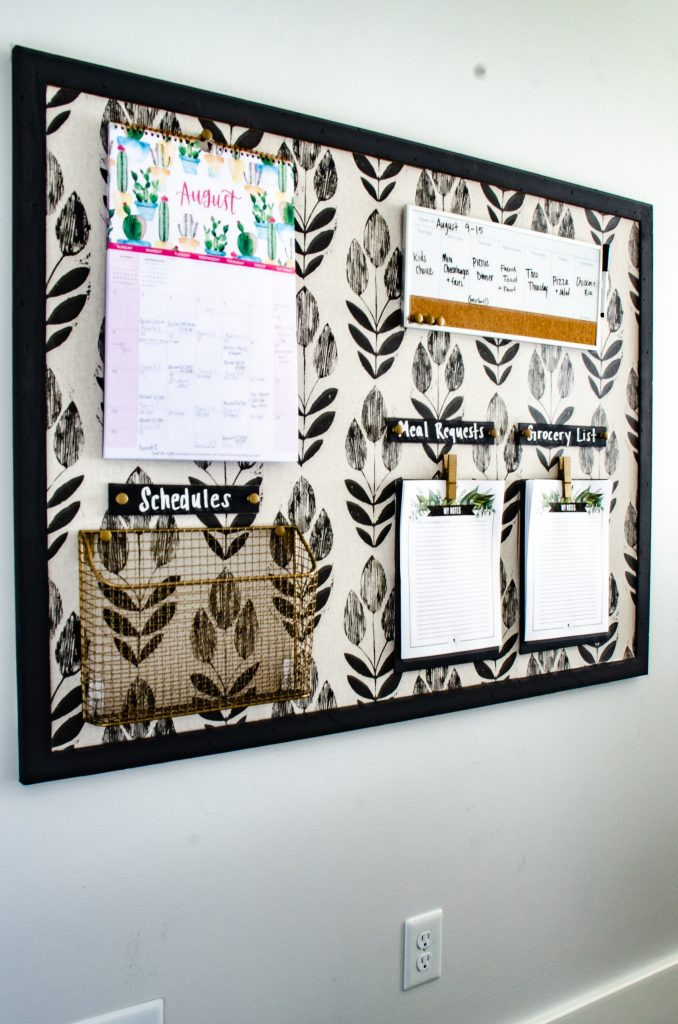 Command Center with a cork board, calendar, wall basket and white board organizer
Command Center with a cork board, calendar, wall basket and white board organizer
7.4. System Not Working
- Evaluate Needs: Re-evaluate your family’s needs and make adjustments to your command center system as needed.
- Seek Input: Seek input from family members to identify any areas for improvement.
- Experiment: Experiment with different solutions and strategies to find what works best for your family.
- Professional Help: Consider seeking professional help from a professional organizer or family therapist.
8. The Digital Family Command Center: Apps and Online Tools
In today’s digital age, there are numerous apps and online tools that can help you create a digital family command center.
8.1. Calendar Apps
- Google Calendar: A free and versatile calendar app that allows you to share calendars with family members and sync across multiple devices.
- Cozi: A family calendar app that includes features for managing schedules, to-do lists, and grocery lists.
- TimeTree: A shared calendar app that allows you to create multiple calendars for different purposes, such as work, school, and family.
8.2. Task Management Apps
- Trello: A visual task management app that allows you to create boards, lists, and cards to track tasks and projects.
- Asana: A project management app that is designed for teams but can also be used to manage family tasks and responsibilities.
- Todoist: A simple and intuitive to-do list app that allows you to create and manage tasks, set reminders, and track your progress.
8.3. Communication Apps
- Slack: A messaging app that allows you to create channels for different topics, such as family announcements, chores, and school updates.
- WhatsApp: A messaging app that allows you to send text messages, photos, and videos to family members.
- Marco Polo: A video messaging app that allows you to send short video messages to family members at any time.
8.4. Family Organization Apps
- OurHome: A family organization app that includes features for managing chores, rewards, and grocery lists.
- Picniic: A family organizer app that includes features for managing calendars, lists, and recipes.
- Flayk: An app designed to help parents coordinate kid’s activities, chat, share photos, and stay connected with other parents.
8.5. Combining Digital and Physical Tools
- Hybrid Approach: Consider using a combination of digital and physical tools to create a family command center that works best for your family.
- Digital Calendar with Physical Board: Use a digital calendar to manage schedules and appointments, but also maintain a physical communication board for important messages and reminders.
- Task Management App with Chore Chart: Use a task management app to track chores and responsibilities, but also maintain a physical chore chart for younger children.
9. Family Command Center Ideas for Different Life Stages
The needs of a family command center will vary depending on the ages and stages of the children in the family. Here are some ideas for adapting your command center to different life stages:
9.1. Families with Young Children
- Visual Schedules: Use visual schedules to help young children understand their daily routines.
- Chore Charts with Pictures: Use chore charts with pictures to assign age-appropriate chores.
- Toy Storage: Provide plenty of toy storage to keep the command center tidy.
- Safety Features: Implement safety features to protect young children, such as outlet covers and corner protectors.
9.2. Families with School-Aged Children
- Homework Station: Create a dedicated homework station with supplies and resources.
- School Calendar: Display the school calendar to keep track of important dates and events.
- Backpack Storage: Provide a designated space for backpacks and school supplies.
- Reading Nook: Create a cozy reading nook to encourage reading.
9.3. Families with Teenagers
- Digital Calendar: Use a digital calendar to manage teenagers’ busy schedules.
- Communication App: Use a communication app to stay in touch with teenagers and keep them informed.
- Study Space: Provide a quiet study space for teenagers.
- Privacy: Respect teenagers’ privacy by providing a separate communication board or space for personal messages.
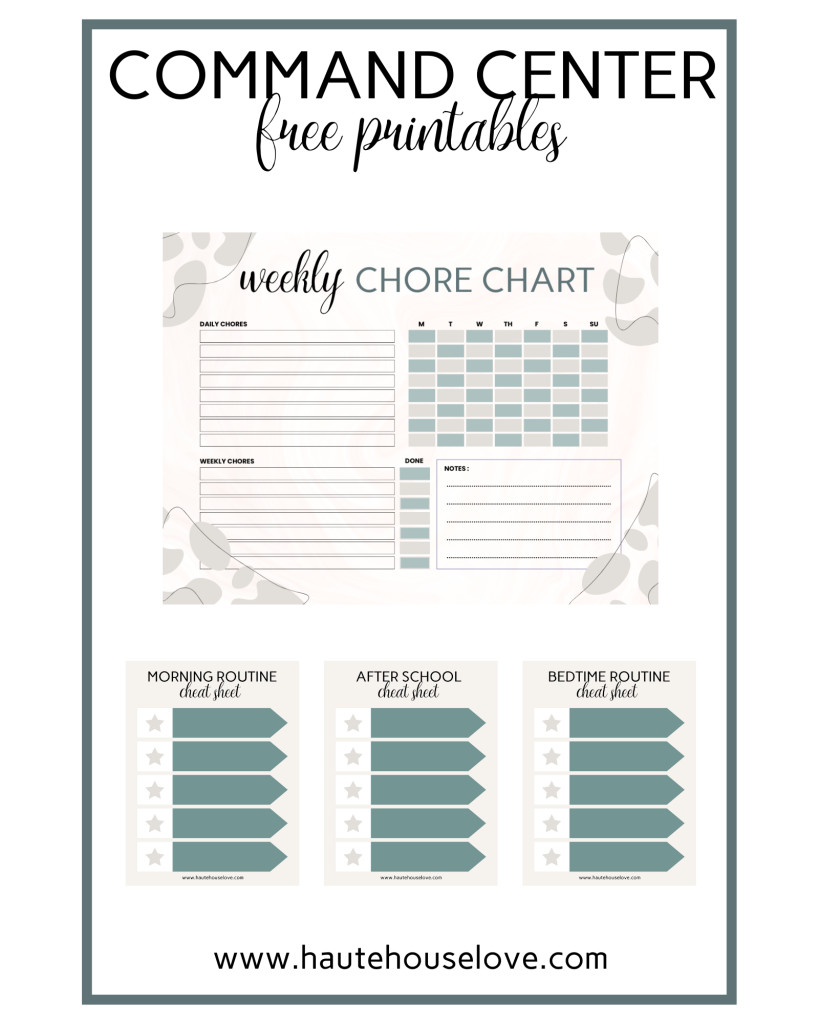 Command Center Printables
Command Center Printables
9.4. Empty Nesters
- Photo Display: Create a photo display to showcase family memories.
- Guest Calendar: Use a guest calendar to plan visits from children and grandchildren.
- Hobby Space: Create a hobby space for pursuing interests and activities.
- Downsize: Downsize the command center to reflect the changing needs of the household.
10. Expert Tips and Advice for Creating a Successful Family Command Center
To help you create a family command center that is both functional and successful, here are some expert tips and advice:
10.1. Consult with Family Members
- Gather Input: Gather input from all family members to ensure that the command center meets everyone’s needs.
- Collaboration: Work together to design and set up the command center.
- Compromise: Be willing to compromise to accommodate different preferences and needs.
- Open Communication: Maintain open communication throughout the process to address any concerns or challenges.
10.2. Start Small and Simple
- Avoid Overwhelm: Avoid trying to do too much at once.
- Focus on Essentials: Focus on the essential components of a command center, such as a calendar, communication board, and task management system.
- Gradual Expansion: Gradually expand your command center as your family’s needs evolve.
- Experimentation: Experiment with different solutions and strategies to find what works best for your family.
10.3. Make It Visually Appealing
- Aesthetics: Choose a color scheme and design that is visually appealing.
- Personalization: Personalize the command center with photos, artwork, and other decorative items.
- Organization: Keep the command center tidy and clutter-free.
- Lighting: Ensure that the command center is well-lit.
10.4. Be Consistent and Patient
- Routine: Establish a routine for using and maintaining the command center.
- Patience: Be patient and understanding, and allow time for your family members to adjust to the new system.
- Persistence: Persist in your efforts, even when you encounter challenges or setbacks.
- Celebrate Successes: Celebrate your successes and acknowledge the positive impact of the command center on your family’s life.
With careful planning, execution, and maintenance, you can create a family command center that will help your family stay organized, connected, and stress-free for years to come. Remember to visit hudsonfamily.net for more ideas and resources to help you create a happy and harmonious home life. Address: 1100 Congress Ave, Austin, TX 78701, United States. Phone: +1 (512) 974-2000.
FAQ: Family Command Centers
1. What is the purpose of a family command center?
A family command center aims to centralize schedules, tasks, and communication, promoting better organization and reducing stress for the entire family.
2. Where is the best place to put a family command center?
Ideal locations include the kitchen, mudroom/entryway, hallway, or home office, depending on traffic flow, space, and visibility.
3. What should I include in my family command center?
Essentials include a calendar, communication board, task management tools, and storage solutions, tailored to your family’s specific needs.
4. How do I get my family to use the command center?
Involve family members in the planning process, communicate the benefits, offer incentives, and be patient as they adjust to the new system.
5. What are some common challenges with family command centers?
Common challenges include resistance from family members, clutter, lack of time, and the system not working effectively.
6. How can I adapt my command center to different life stages?
Customize the command center based on the ages and stages of your children, using visual schedules for young children and digital tools for teenagers.
7. What digital tools can I use for a family command center?
Consider using calendar apps like Google Calendar, task management apps like Trello, and communication apps like Slack or WhatsApp.
8. How do I maintain my family command center?
Establish daily and weekly tasks, involve the whole family in the process, and adapt to changing needs over time.
9. What if my family command center is not working?
Re-evaluate your family’s needs, seek input from family members, experiment with different solutions, and consider professional help if needed.
10. How can hudsonfamily.net help me create a successful family command center?
hudsonfamily.net offers a wealth of articles, resources, and inspiration to help you design and maintain a family command center that meets your unique needs and promotes a happy, organized home life.

